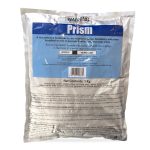Description
Click here to view the Safety Data Sheet
ctive Ingredient: 600g/kg metsulfuron-methyl
Chemical Group: Sulfonyl urea
Formulation: Water dispersible granule
Compatibility: Do not mix PRISM with hormone type products such as 2,4-D and MCPA when treating pasture areas as severe pasture damage will result.
Prism is a GROUP B sulphonylurea herbicide (non-hormonal and non-volatile). Prism may be used with care in situations where a hormone type herbicide may cause unintentional damage through vapour movement. Prism should be applied to actively growing weeds during late spring to early autumn. Prism is rapidly absorbed into the foliage of plants and is translocated within the plant where it rapidly stops cell division. The symptoms in treated plants is a gradual reduction in vigour until plants die. It is effective on weeds such as gorse, blackberry, ragwort, thistles, sweet brier, matagouri, hawthorn, barberry, bracken, broom, manuka, tauhinu, fennel, horehound, inkweed, tutu, willows, wild ginger, old mans beard, privet and many broadleaf weeds.
Notes:
- BEWARE – Apply this product carefully. Spray drift may cause serious damage to other desirable plants.
- Avoid use over or near any desirable plants and in areas where their roots may extend, nor in areas where the chemical may be washed or moved into the plant’s root zone.
- PRISM is extremely injurious to Clover/Ryegrass pastures. Allow a minimum period of 3 months to
elapse before attempting to oversow. The soil residual life of PRISM varies between soil types, rainfall and rate of application. It is recommended that a small test area is sown 1-2 months before any large scale oversowing is undertaken. Browntop is a resistant grass species and this may be sown on areas where quick ground cover is required. - Rainfall within 1 hour of treatment may reduce the effectiveness of PRISM.
WEEDS CONTROLLED: Barberry, Blackberry, Bracken, Broom, Fennel, Gorse , Hawthorn, Horehound, Inkweed, Manuka, Matagouri, Old mans Beard, Privet, Ragwort, Thistles, Sweet brier, Tauhinu, Tutu, Wild ginger, Willows.
WEEDS NOT CONTROLLED: Black nightshade, Woolly nightshade, Boxthorn and many grass species including Browntop, Cocksfoot, Kikuyu, Pampas and Paspalum.
AERIAL APPLICATION: Use an experienced, licensed aerial applicator. Apply using the half overlap flying technique and a nozzle configuration and flight pattern that will ensure good canopy penetration and full coverage of sprayed plants. Poor coverage will result in significant regrowth. After application, it is essential to follow up with management practices such as slashing, crushing, burning of bushes and over-sowing of pasture species.
Note: Aerial application is recommended for use in non-crop areas only.
MIXING: Add the required amount of PRISM directly into a half-filled spray tank. Agitate before and during application.
COMPATIBILITY: Do not mix PRISM with hormone type products such as 2,4-D and MCPA when treating pasture areas as severe pasture damage will result.
SPRAYER CLEANUP: In order to avoid subsequent injury to crops, ensure that immediately after spraying all traces of PRISM are removed from mixing and spray equipment using the following cleaning method:
First drain the tank, then flush the tank, boom and hoses with clean water for a minimum of 10 minutes. Then:
- Fill the tank with clean water and add 1 litre chlorine bleach (containing 3% solution of sodium hypochlorite) per 100 litres of water. Flush this mixture through the system while agitating, then drain.
- Repeat step 2.
- Nozzles and screens should be removed and cleaned separately. To remove traces of chlorine bleach, rinse the tank thoroughly with clean water and flush through hoses and boom.
IT IS AN OFFENCE FOR USERS OF THIS PRODUCT TO CAUSE RESIDUES EXCEEDING THE RELEVANT MRL IN THE NEW ZEALAND (MAXIMUM RESIDUE LIMITS OF AGRICULTURAL COMPOUNDS) FOOD STANDARDS.
WITHHOLDING PERIODS: Do NOT graze treated areas with dairy cows within 3 days after application and other stock within 1 day of application.
Resistant Weeds Warning:
Prism is a member of the sulfonyl urea group of herbicides. Naturally occurring biotypes resistant to sulfonyl urea herbicides are known to exist. These resistant weeds will not be controlled by Prism or other sulfonyl urea herbicides. To prevent or delay the development of resistant weeds use Prism in tank mixes (if appropriate) and/or rotations with herbicides having different modes of action effective on the same weed species. Since the occurrence of resistant weeds is difficult to detect prior to use, Adria New Zealand Limited accepts no liability for any losses that may result from the failure of Prism to control resistant weeds.
Registered pursuant to the ACVM Act 1997, Approval No. P7679







